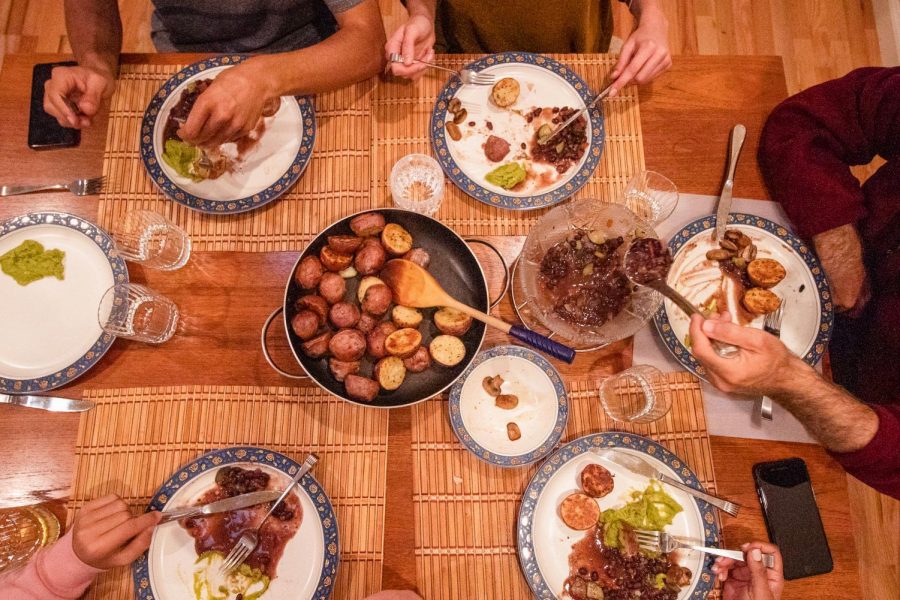Strategic Cooking in the Time of COVID
Using potatoes, plantain, or yuca can really help make a simple meal filling and delicious.
The COVID-19 pandemic has created a mountain of new health and economic challenges for people across the globe. For some people in the U.S., it marks the first time they are experiencing food insecurity or food scarcity as panicked shoppers swarm grocery stores and “panic buy,” preparing for the worst case scenario.
Though food service workers and laborers continue to work to sustain the food supply chain—and their own livelihoods—there are certain shortages that have come as a result of the pandemic and nationwide trends of panic buying. With these shortages, many have had to get creative in the kitchen as they try to feed themselves and their families.
For many, though, food insecurity predates this pandemic, affecting nearly 13% of Americans in 2017, according to Feeding America. Now, the millions of people in the U.S. who live in food deserts are additionally strained as they have to drive further to reach a grocery store, where they may not even be able to purchase enough food to feed their families.
For those people and for everyone experiencing food insecurity now, below is a short compilation of some easy substitutions and adjustments that can be made to make your groceries last longer—pandemic or not.
Tofu/Veggie Substitutes
Seattle is experiencing a tofu shortage. Before you panic, know that there are other meatless substitutes that can be used to supplement your meals as a protein replacement. Tempeh is one of the closest things to the texture of tofu and can be utilized in the same way. It comes from fermentation of the whole soybean, and is therefore more dense and flavorful—and higher in fiber and iron. Seitan, a flavored wheat gluten dough, is another alternative that can be used to replicate the feel of meat, as it is a bit chewier. High in protein, seitan can be found in many grocery stores and has a high protein content.
Frozen Foods
Frozen meals get a bad rap in my opinion, when in reality they make a quick, cheap and filling meal for yourself or your family. Trader Joe’s in particular is a great chain that offers an affordable array of frozen foods to serve as a snack or entire dinner.
While some people have taken this time of isolation as an opportunity to spruce up their culinary skills, others may not have that opportunity due to work and personal responsibilities taking up more time. Frozen foods and snacks provide an efficient way to stay fed during an especially stressful period. They can also serve as a great base for a meal, with the addition of a fried egg or fresh veggies taking the meal to a more filling level.
Flour Substitutes
As nervous shoppers flocked grocery stores across the country in a panic, one of the hardest hit food products was all-purpose flour, which is now nearly impossible to find in some stores across the country. If you’re like me, and use flour nearly every day to sustain your cookie habit, this can cause another personal panic in the home. Rest assured, as there are other more than suitable alternatives to the ever versatile all-purpose flour: gluten-free flour and almond flour are two alternatives that seem to be more available in stores.
Gluten-free flour can work well in many cases, though it may be best to stick to all-purpose or almond flour for recipes that require a precise measurement, as gluten free flour can have more of an effect on the rise of a bread or pastry. To adapt a cake or bread recipe to gluten-free flour, add 1 teaspoon of xanthan gum, which can be found at stores like Kroger and Target.
Almond flour is another slightly sweeter alternative—naturally gluten free and wheat free itself—that has recently gained popularity in the baking community. For most recipes, simply do a 1:1 substitution with the almond flour for the same good, though it may end up slightly more dense compared to using all-purpose flour.
Bulk Foods
Here, I’d like to make the case for staple foods that feed a village. Some people may have to say goodbye to their 15 ingredient meals and “settle” for staple meals which are often frowned upon as being cheap and low-quality, though they are integral to the cooking of minoritized communities and cultures.
With some easy to make rice and beans, you can feed a family for weeks—especially with the addition of chicken or veggies. For an endless supply of meals for the week, simply boil beans with an onion, salt and garlic and for classic spanish rice, add diced tomatoes and onion to rice on the stove. Here, as always, spices are the key.
Another adaptable and surprisingly easy-to-make option is dumplings. For about ten dollars, you can prepare a personal, week-long dinner. All you need is a pack of gyoza dumpling wrappers that can be found at Asian supermarkets—most American chain grocery stores don’t carry them. If you have the time to wrap your own at home, it’s a cheaper and fresher option compared to frozen potstickers. Simply fill your wrappers with any filling of your choice—whether it be scrambled egg, ground pork, or shrimp—and fold into a potsticker. These can then be frozen and stored for later or boiled, fried or steamed.
Hopefully this list provides some helpful alternatives for a changing grocery landscape, where all can benefit.










